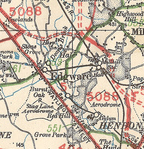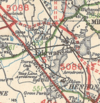A5088 (Watford Bypass)
| A5088 | ||||
 | ||||
| ||||
| From: | West Hampstead (TQ250860) | |||
| To: | Hunton Bridge (TQ085995) | |||
| Distance: | 14.6 miles (23.5 km) | |||
| Met (1930): | A500, A407, A406, A5000, A5093, A5092, A41, A5, A411, A409, A412, A405, A41 | |||
| Former Number(s): | A500 | |||
| Now part of: | A41, A1 | |||
| Primary Destinations | ||||
| Traditional Counties | ||||
| Route outline (key) | ||||
| ||||
For the current A5088, on the Wirral, see A5088.

The A5088 was the original number for the Watford bypass. The road was allocated its number on completion in the mid-1920s. The road was subsequently extended southwards to bypass Edgware and Cricklewood, giving the road its full length. The road was renumbered as a rerouting of the A500 in 1935, then in the 1950s became the mainline of the A41, the road it had bypassed in the first place.
The road started on the A500 to the north of West Hampstead. The A41 still changes from single- to dual-carriageway here, showing the start of the new-build. The road headed northwest via Brent Cross and the A406 before passing between Hendon and Colindale. The Barnet bypass came in from the right as the A5093 and left over a mile later as the A5092 (both of these are now part of the A1, as is the former A5088 between them), after which the road headed west to complete the Edgware bypass and meet the original A41 (now A410).
The Watford bypass started here and so the A5088 continued north to bypass Bushey and Watford before returning to the A41 to the north of town at what is now the Hunton Bridge roundabout.

